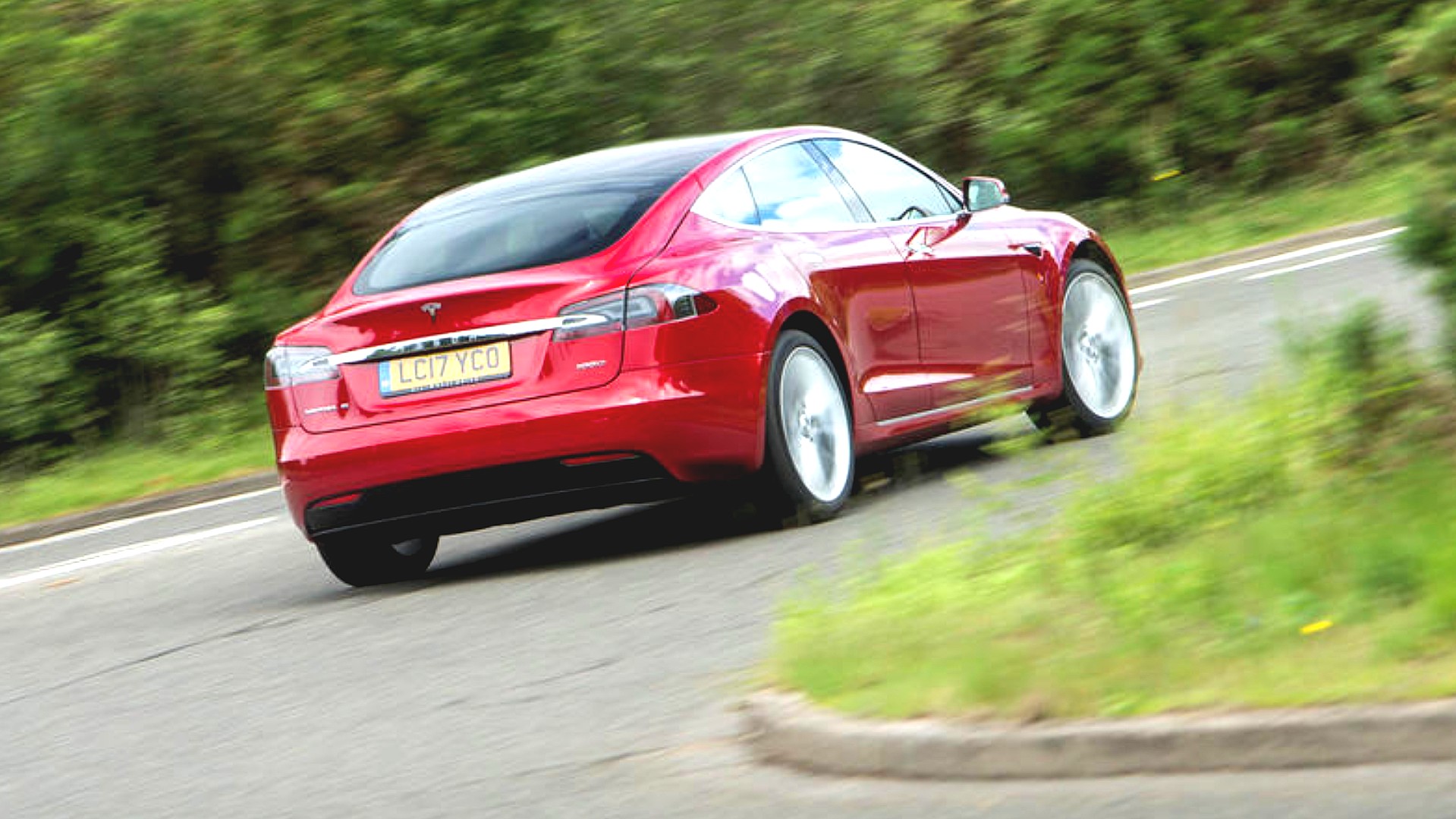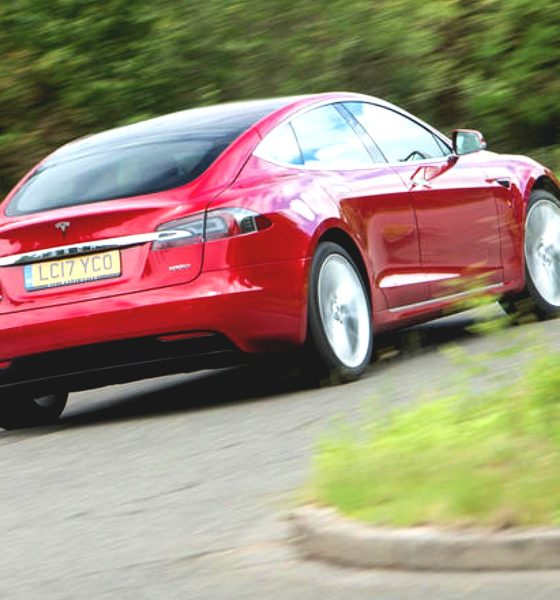

News
Elon Musk teases Tesla Model S updates: ‘Plaid Powertrain,’ triple motors, 7-seat option, and higher price
Sightings of a Tesla Model S P100D+ unit near the Nürburgring have caught the electric car community by storm, particularly due to the vehicle’s unique characteristics. In a series of tweets, CEO Elon Musk shared some details about the vehicle, providing a glimpse at what is to come for Tesla’s flagship sedan.
Immediately noticeable in the Model S spotted near the Nürburgring is the vehicle’s design, which differs from the current offerings of the company. Apart from the vehicle’s large, wide, Michelin Cup 2 R tires, the Model S near the German track is equipped with a proper spoiler and wider fender flares. The sedan’s lower grille also looks noticeably larger than those found in the current-generation Model S.
These design elements make the Model S at the Nürburgring look very aggressive and worthy of the P100D+ badge that was spotted at its rear. Posting about the sighting, senior road tester Paul Maric of CarAdvice.com added that former Formula One champion Nico Rosberg, who has volunteered his driving services to Tesla for its Nürburgring run, recently stated that he and the electric car maker are “still in discussions.”
Overall, the Model S that Tesla seems to be preparing for its run at the nearly 13-mile German track provides a clear hint at some upgrades that are coming to the company’s flagship sedan. The Model S is Tesla’s first vehicle that was designed from a clean sheet, and it stands as the electric car that pretty much proved that EVs could be superior compared to gas-powered cars. Unfortunately, the Model S has been overshadowed for the most part by the Model 3 as of late, considering that the more affordable vehicle comprises the vast majority of Tesla’s sales today.
If Elon Musk’s tweets are any indication, the Model S will soon be improved with several upcoming upgrades that will make it worthy of its flagship status, and more. Following Tesla’s release of the vehicle’s record-setting lap at the Laguna Seca Raceway, for example, Musk mentioned a “Plaid Powertrain” update for the sedan, which appears to address the throttling issues that were prevalent in older Model S units. Musk also confirmed that the new Model S will have a three-motor configuration, a setup that was initially announced for the next-generation Roadster.
These upgrades will not only make the Model S track-capable, but they will likely improve the flagship sedan’s already-ludicrous 0-60 mph time of 2.4 seconds. Of course, such improvements will likely come at a price. This was mentioned by Elon Musk on Twitter, when he said that the Model S with Plaid Powertrain and triple motors will cost more than the company’s current offerings but less than competitors. Considering that the Porsche Taycan Turbo and Turbo S are pretty much the Model S’ only legitimate competitor in the market today, Musk appears to be hinting at a price below $150,000.
As a final detail, Musk added that the Model S with Plaid Powertrain that is currently in Germany is equipped with seven seats. This would be a welcome return for the option, considering that the vehicle’s rear-facing jump seats at the rear made the Model S a champion of utility in the past. All things considered, it is difficult to deny that the idea of a triple-motor, track-capable electric sedan that can seat seven people is beyond ludicrous — it’s downright plaid.

Elon Musk
Elon Musk and Tesla AI Director share insights after empty driver seat Robotaxi rides
The executives’ unoccupied tests hint at the rapid progress of Tesla’s unsupervised Robotaxi efforts.

Tesla CEO Elon Musk and AI Director Ashok Elluswamy celebrated Christmas Eve by sharing personal experiences with Robotaxi vehicles that had no safety monitor or occupant in the driver’s seat. Musk described the system’s “perfect driving” around Austin, while Elluswamy posted video from the back seat, calling it “an amazing experience.”
The executives’ unoccupied tests hint at the rapid progress of Tesla’s unsupervised Robotaxi efforts.
Elon and Ashok’s firsthand Robotaxi insights
Prior to Musk and the Tesla AI Director’s posts, sightings of unmanned Teslas navigating public roads were widely shared on social media. One such vehicle was spotted in Austin, Texas, which Elon Musk acknowleged by stating that “Testing is underway with no occupants in the car.”
Based on his Christmas Eve post, Musk seemed to have tested an unmanned Tesla himself. “A Tesla with no safety monitor in the car and me sitting in the passenger seat took me all around Austin on Sunday with perfect driving,” Musk wrote in his post.
Elluswamy responded with a 2-minute video showing himself in the rear of an unmanned Tesla. The video featured the vehicle’s empty front seats, as well as its smooth handling through real-world traffic. He captioned his video with the words, “It’s an amazing experience!”
Towards Unsupervised operations
During an xAI Hackathon earlier this month, Elon Musk mentioned that Tesla owed be removing Safety Monitors from its Robotaxis in Austin in just three weeks. “Unsupervised is pretty much solved at this point. So there will be Tesla Robotaxis operating in Austin with no one in them. Not even anyone in the passenger seat in about three weeks,” he said. Musk echoed similar estimates at the 2025 Annual Shareholder Meeting and the Q3 2025 earnings call.
Considering the insights that were posted Musk and Elluswamy, it does appear that Tesla is working hard towards operating its Robotaxis with no safety monitors. This is quite impressive considering that the service was launched just earlier this year.
Elon Musk
Starlink passes 9 million active customers just weeks after hitting 8 million
The milestone highlights the accelerating growth of Starlink, which has now been adding over 20,000 new users per day.

SpaceX’s Starlink satellite internet service has continued its rapid global expansion, surpassing 9 million active customers just weeks after crossing the 8 million mark.
The milestone highlights the accelerating growth of Starlink, which has now been adding over 20,000 new users per day.
9 million customers
In a post on X, SpaceX stated that Starlink now serves over 9 million active users across 155 countries, territories, and markets. The company reached 8 million customers in early November, meaning it added roughly 1 million subscribers in under seven weeks, or about 21,275 new users on average per day.
“Starlink is connecting more than 9M active customers with high-speed internet across 155 countries, territories, and many other markets,” Starlink wrote in a post on its official X account. SpaceX President Gwynne Shotwell also celebrated the milestone on X. “A huge thank you to all of our customers and congrats to the Starlink team for such an incredible product,” she wrote.
That growth rate reflects both rising demand for broadband in underserved regions and Starlink’s expanding satellite constellation, which now includes more than 9,000 low-Earth-orbit satellites designed to deliver high-speed, low-latency internet worldwide.
Starlink’s momentum
Starlink’s momentum has been building up. SpaceX reported 4.6 million Starlink customers in December 2024, followed by 7 million by August 2025, and 8 million customers in November. Independent data also suggests Starlink usage is rising sharply, with Cloudflare reporting that global web traffic from Starlink users more than doubled in 2025, as noted in an Insider report.
Starlink’s momentum is increasingly tied to SpaceX’s broader financial outlook. Elon Musk has said the satellite network is “by far” the company’s largest revenue driver, and reports suggest SpaceX may be positioning itself for an initial public offering as soon as next year, with valuations estimated as high as $1.5 trillion. Musk has also suggested in the past that Starlink could have its own IPO in the future.
News
NVIDIA Director of Robotics: Tesla FSD v14 is the first AI to pass the “Physical Turing Test”
After testing FSD v14, Fan stated that his experience with FSD felt magical at first, but it soon started to feel like a routine.

NVIDIA Director of Robotics Jim Fan has praised Tesla’s Full Self-Driving (Supervised) v14 as the first AI to pass what he described as a “Physical Turing Test.”
After testing FSD v14, Fan stated that his experience with FSD felt magical at first, but it soon started to feel like a routine. And just like smartphones today, removing it now would “actively hurt.”
Jim Fan’s hands-on FSD v14 impressions
Fan, a leading researcher in embodied AI who is currently solving Physical AI at NVIDIA and spearheading the company’s Project GR00T initiative, noted that he actually was late to the Tesla game. He was, however, one of the first to try out FSD v14.
“I was very late to own a Tesla but among the earliest to try out FSD v14. It’s perhaps the first time I experience an AI that passes the Physical Turing Test: after a long day at work, you press a button, lay back, and couldn’t tell if a neural net or a human drove you home,” Fan wrote in a post on X.
Fan added: “Despite knowing exactly how robot learning works, I still find it magical watching the steering wheel turn by itself. First it feels surreal, next it becomes routine. Then, like the smartphone, taking it away actively hurts. This is how humanity gets rewired and glued to god-like technologies.”
The Physical Turing Test
The original Turing Test was conceived by Alan Turing in 1950, and it was aimed at determining if a machine could exhibit behavior that is equivalent to or indistinguishable from a human. By focusing on text-based conversations, the original Turing Test set a high bar for natural language processing and machine learning.
This test has been passed by today’s large language models. However, the capability to converse in a humanlike manner is a completely different challenge from performing real-world problem-solving or physical interactions. Thus, Fan introduced the Physical Turing Test, which challenges AI systems to demonstrate intelligence through physical actions.
Based on Fan’s comments, Tesla has demonstrated these intelligent physical actions with FSD v14. Elon Musk agreed with the NVIDIA executive, stating in a post on X that with FSD v14, “you can sense the sentience maturing.” Musk also praised Tesla AI, calling it the best “real-world AI” today.








